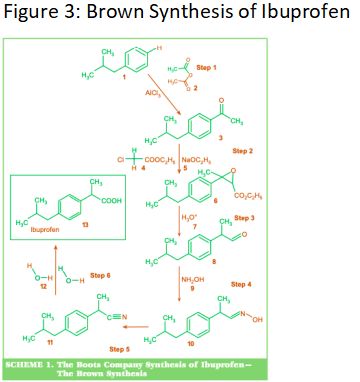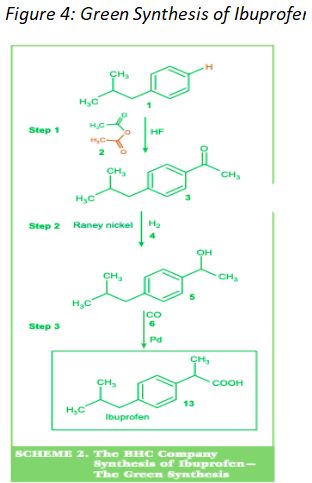Using Greener Synthetic Pathways Produce Pharmaceuticals Is Better for the Environment ?
- Country :
Australia
Claim
This research investigation will explore the claim, Using greener synthetic pathways to produce pharmaceuticals better for the environment.
Rationale
The importance of being environmentally conscious is incredibly relevant today. With the rise of global warming and ecosystem pollution it is vital we are making sustainability a priority (Arora, 2018). The development of mass-produced goods has resulted in threatening amounts of waste being made annually. The environment contains abiotic and biotic factors that keep a fragile balance within ecosystems. The disruption of which may cause unchangeable damages. Figure 1 shows the pharmaceutical industry has one of the highest rates of wastage.

Ibuprofen is one of the worlds most popular nonsteroidal anti-inflammatory drug with over 20,000 tonnes being produced annually (BBC, 2015). It is used to relieve pain, fever, and inflammation. The drug Ibuprofen is chemically referred to as 2-(4-isobutylphenyl) propionic acid with the structural formula shown in Figure 2. Given Ibuprofens significance in the pharmaceutical industry it is important to monitor the environmental outcomes of its production.
Green chemistry measures how sustainable a chemical process is. The principles of green chemistry reduce the impact of chemical activities on human health and the environment (YU, 2023). The twelve principles of green chemistry are shown graphically in Figure 3. Evidently one of which is atomy economy. Atom economy refers to the proportion of reactants that end up in the final product, it is a measure of the reaction efficiency (Cann, 2023). Atom economy is calculated by:
Within this investigation atom economy is used
+Talk about by-products
Therefore, this investigation proposes the following research question.
=molecular weight of desired product/total molecular weight of all reactants*100
Research Question
Has reducing production steps in the synthesize of Ibuprofen increased the reactions atom economy and reduced production of by-products, and hence become better for the environment?
Background
Ibuprofen was originally synthesized using the Boots method, also referred to as brown and commercial synthesis. This process involved a 6-step process, graphically shown in Figure 3. When the company was sold in 1998, the synthesis process was adapted to incorporate green principles. During which, the production steps were reduced to 3, shown in Item 2. Within this report this is referred to as the green synthesis/route of Ibuprofen production.
The first step in both routes yields the same product via the acylation of isobutylbenzene- the addition of an acyl group to a substrate.

In the brown synthesis, Aluminium trichloride is used in stoichiometric amounts, which generates large amounts of aluminium trichloride hydrate as a waste by-product that is generally landfilled. In contrast, the green synthesis uses hydrogen fluoride as a catalyst that is recovered and reused repeatedly.
From this knowledge when Ibuprofen is synthesised using, the six-step process it can be precited it will produced a lower atom economy and a larger amount of by-products..

+green principles?
Evidence


Trends, patterns, and relationships
Dataset A shows an increase of atom economy when production step numbers decrease. The brown synthesis of Ibuprofen referenced in Table 1a involves a 6-step process, shown in Appendix item 1. Evidently Table 1a shows the percentage atom economy for this process was 40%. Thus, the majority, 60% (by weight), of all the reagent atoms in this synthesis are incorporated into unwanted by-products or waste. In comparison the green synthesis in Table 2a has a 3-step process. The green synthesis has an atom economy of 77%, which climbs to 99% if the acetic acid generated is recovered. This process results in less than 1% of the reagent atoms being wasted.
Dataset B shows the reduction of by-products when production steps are decreased. Table 2a shows the total molecular mass of waste products is 308.5 via commercial synthesis. In comparison the molecular mass of waste products via green synthesis is 60. This value is significantly lower.
Interpretation of the evidence
By reducing the number of production steps, the overall efficiency of the synthesis process was improved, leading to higher atom economy. Each step involved the use of reagents and solvents caused the loss of atoms and generation of unwanted by-products. Eliminating unnecessary steps and optimizing reaction conditions minimized the use of additional reagents and reduced waste formation. This allowed for a higher proportion of the starting material's atoms to be incorporated into the desired pharmaceutical product.
Are you struggling to keep up with the demands of your academic journey? Don't worry, we've got your back! Exam Question Bank is your trusted partner in achieving academic excellence for all kind of technical and non-technical subjects.
Our comprehensive range of academic services is designed to cater to students at every level. Whether you're a high school student, a college undergraduate, or pursuing advanced studies, we have the expertise and resources to support you.
To connect with expert and ask your query click here Exam Question Bank

